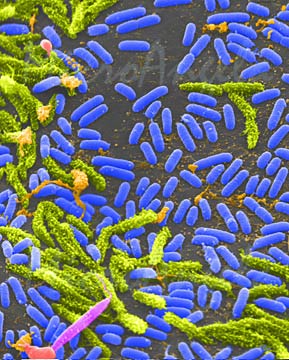

| Grows on you |
 Bacteria
Bacteria are unicellular ("one cell"), prokaryotic organisms that
are usually microscopic, ranging from 0.2 to 10 micrometers (1
micrometer equals 1/25,000 inch). They generally lack organelles,
such as a nucleus. About 4000 species have been identified, and
there are probably lots more. There are bacteria that live in air,
soil, freshwater, seawater, hot springs, frozen soil, on plants,
animals, and on and in you! Some foods we enjoy are produced by
bacteria, such as cheese, yogurt, and pickles. Other bacteria can
be harmful and cause diseases, such as the pathogenic Streptococcus.
|
|
 |

|
 |
 |
 |
||||
| Mold | Bacteria | Leptospira | Penicillum | More Stuff |
|
Copyright © 1996-2000 Tina (Weatherby) Carvalho...MicroAngela This material may not be reproduced in any form without express written permission. |